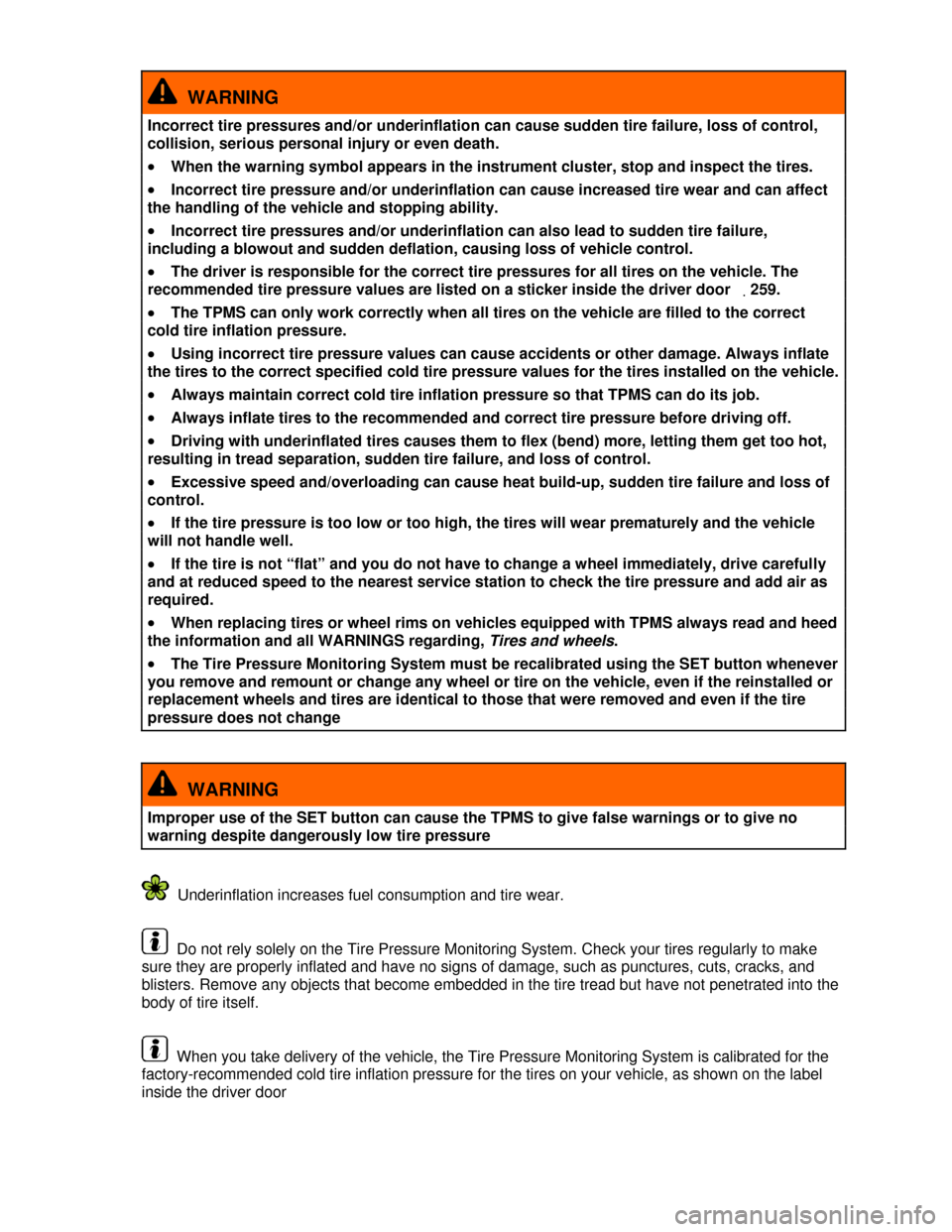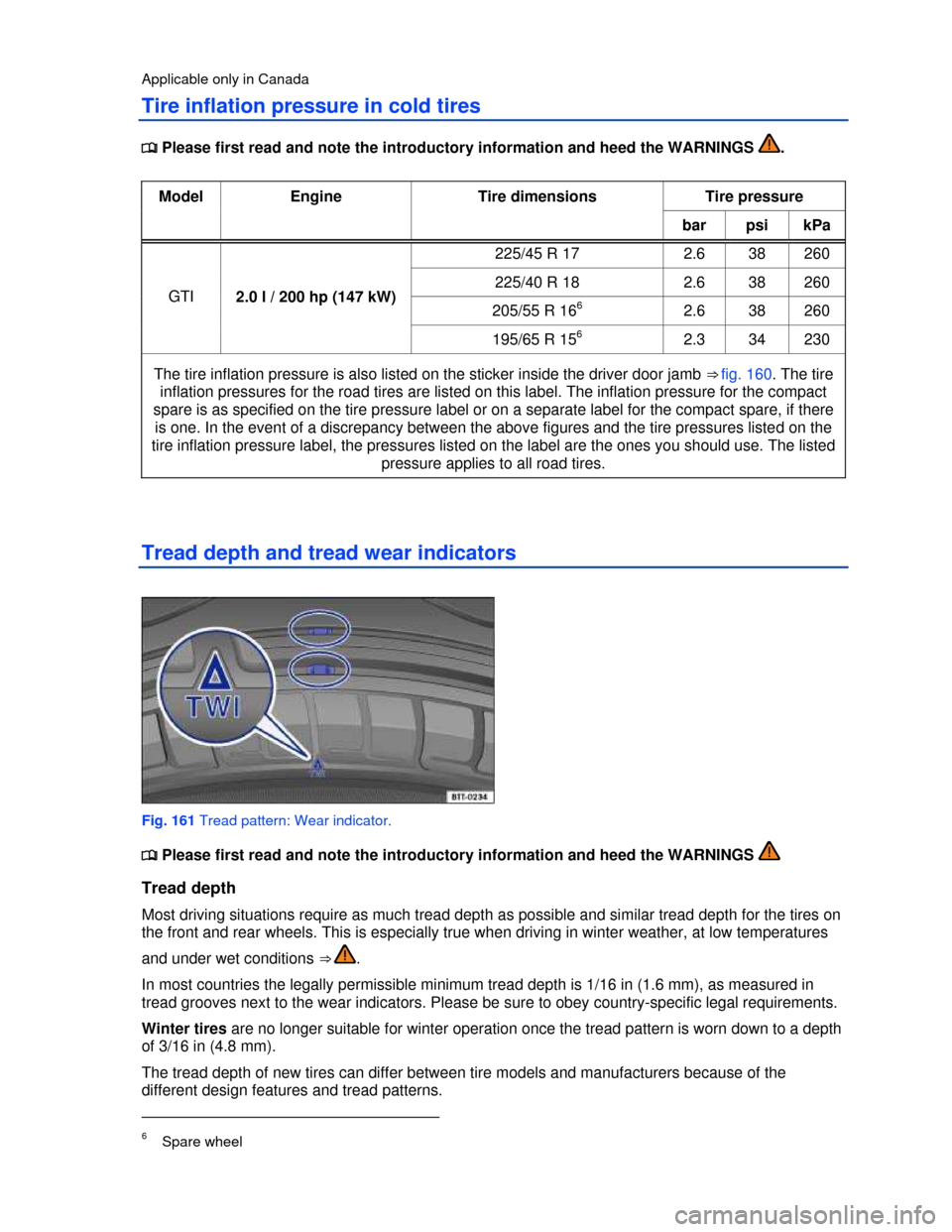2013 VOLKSWAGEN GOLF GTI flat tire
[x] Cancel search: flat tirePage 136 of 319

Driving tips
Introduction
In this section you’ll find information about:
Stowing luggage
Driving with an open rear hatch
Driving a loaded vehicle
Weights and axle weights
Always stow heavy objects in the luggage compartment and make sure that the rear seat backrests
are securely latched. Always use the tie-downs in the luggage compartment and secure the objects
with suitable straps. Never overload the vehicle. Remember that the vehicle load, as well as how it is
distributed, can affect vehicle handling and braking ⇒ .
More information:
�x Rear hatch
�x Folding the passenger seat backrest forward
�x Lights
�x Luggage compartment
�x Roof rack
�x Trailer towing
�x Tires and wheels
WARNING
Unsecured or incorrectly stowed items can fly through the vehicle, causing serious personal
injury during hard braking or sharp steering or in an accident. Loose items can also be struck
and thrown through the passenger compartment by the front airbags if they inflate. To help
reduce the risk of serious personal injury:
�x Always stow all objects securely in the vehicle.
�x Always keep storage compartments closed while driving.
�x Do not stow hard, heavy, or sharp objects in open bins in the vehicle or on top of the
instrument panel.
�x Remove hard, heavy, and sharp objects from clothing and bags in the vehicle interior and
stow securely. Always put heavy items in the luggage compartment.
�x Always secure objects in the passenger compartment properly with suitable straps so that
they cannot move into the deployment area of a side or front airbag during braking, in a
sudden maneuver, or in a collision.
�x Always make sure that there is nothing on the front passenger seat when the backrest is
folded forward. When the backrest is folded forward, even light objects could be pushed into
the seat cushion and cause the weight-sensing mat in the seat to register enough weight to
turn the airbag on
�x Always make sure that the PASSENGER AIR BAG OFF 9 light is on and stays on whenever
the backrest of the front passenger seat is folded forward
�x Passengers must never ride in an incorrect seating position because objects are being
transported in the vehicle.
�x Never let anybody sit in a seat that is blocked by objects being carried in the vehicle.
Page 150 of 319

Roof rack
Introduction
In this section you’ll find information about:
Attaching the roof rack base carrier and roof rack
Securing a load on the roof rack
The roof of your vehicle has been designed to optimize aerodynamics and does not have traditional
rain gutters that are used to attach many kinds of roof racks.
Since the rain gutters are molded into the roof to provide efficient aerodynamics, only Volkswagen-
approved base carrier mounts and roof racks can be used.
When should the roof rack be removed?
�x When it is no longer needed.
�x Before driving through an automatic car wash.
�x When the vehicle would otherwise be too high for minimum clearance to enter, for example, a
garage.
More information:
�x Lights
�x Transporting
�x Saving fuel and helping the environment
�x Tires and wheels
�x Parts, accessories, repairs and modifications
WARNING
Transporting heavy or bulky loads on the roof rack will change the way the vehicle handles
by shifting the vehicle's center of gravity and increasing the wind drag.
�x Always secure the load properly with suitable and undamaged straps so that the load will
not shift.
�x Cargo that is large, heavy, bulky, long or flat will have a negative effect on the vehicle's
aerodynamics, center of gravity and overall handling.
�x Always avoid sudden maneuvers and hard braking.
�x Always adapt your speed and driving to the heavier load and the weight distribution in the
vehicle. Take road, weather, traffic, and visibility conditions into account as well.
NOTICE
�x Always remove the roof rack before driving through an automatic car wash.
�x Your vehicle is higher when the roof rack is installed, especially when it is loaded. Compare
the vehicle height with existing clearance heights, such as underpasses and garage doors.
�x Always make sure that the roof rack system and anything being carried on it does not
interfere with the roof antenna, the power sunroof or the rear hatch.
�x Make sure that the rear hatch does not touch items on the roof rack when opened.
If a roof rack is installed, fuel consumption increases due to increased air resistance.
Page 201 of 319

WARNING
Incorrect tire pressures and/or underinflation can cause sudden tire failure, loss of control,
collision, serious personal injury or even death.
�x When the warning symbol appears in the instrument cluster, stop and inspect the tires.
�x Incorrect tire pressure and/or underinflation can cause increased tire wear and can affect
the handling of the vehicle and stopping ability.
�x Incorrect tire pressures and/or underinflation can also lead to sudden tire failure,
including a blowout and sudden deflation, causing loss of vehicle control.
�x The driver is responsible for the correct tire pressures for all tires on the vehicle. The
recommended tire pressure values are listed on a sticker inside the driver door .259.
�x The TPMS can only work correctly when all tires on the vehicle are filled to the correct
cold tire inflation pressure.
�x Using incorrect tire pressure values can cause accidents or other damage. Always inflate
the tires to the correct specified cold tire pressure values for the tires installed on the vehicle.
�x Always maintain correct cold tire inflation pressure so that TPMS can do its job.
�x Always inflate tires to the recommended and correct tire pressure before driving off.
�x Driving with underinflated tires causes them to flex (bend) more, letting them get too hot,
resulting in tread separation, sudden tire failure, and loss of control.
�x Excessive speed and/overloading can cause heat build-up, sudden tire failure and loss of
control.
�x If the tire pressure is too low or too high, the tires will wear prematurely and the vehicle
will not handle well.
�x If the tire is not “flat” and you do not have to change a wheel immediately, drive carefully
and at reduced speed to the nearest service station to check the tire pressure and add air as
required.
�x When replacing tires or wheel rims on vehicles equipped with TPMS always read and heed
the information and all WARNINGS regarding, Tires and wheels.
�x The Tire Pressure Monitoring System must be recalibrated using the SET button whenever
you remove and remount or change any wheel or tire on the vehicle, even if the reinstalled or
replacement wheels and tires are identical to those that were removed and even if the tire
pressure does not change
WARNING
Improper use of the SET button can cause the TPMS to give false warnings or to give no
warning despite dangerously low tire pressure
Underinflation increases fuel consumption and tire wear.
Do not rely solely on the Tire Pressure Monitoring System. Check your tires regularly to make
sure they are properly inflated and have no signs of damage, such as punctures, cuts, cracks, and
blisters. Remove any objects that become embedded in the tire tread but have not penetrated into the
body of tire itself.
When you take delivery of the vehicle, the Tire Pressure Monitoring System is calibrated for the
factory-recommended cold tire inflation pressure for the tires on your vehicle, as shown on the label
inside the driver door
Page 203 of 319

WARNING
Incorrect tire pressures and/or underinflation can cause sudden tire failure, loss of control,
collision, serious personal injury, or even death.
�x When the warning symbol Ç appears in the instrument cluster, stop the vehicle as soon as
it is safe to do so and inspect all tires.
�x Incorrect tire pressure and/or underinflation can cause increased tire wear and can affect
the handling of the vehicle and its stopping ability.
�x Incorrect tire pressure and/or underinflation can also lead to sudden tire failure, including
a blowout and sudden deflation, causing loss of vehicle control.
�x The driver is responsible for the correct tire pressures for all tires on the vehicle. The
recommended tire pressure values are listed on a sticker inside the driver door
�x The TPMS can only work correctly when all tires on the vehicle are filled to the correct
cold tire inflation pressure. Always maintain the correct cold tire inflation pressure so that
TPMS can do its job.
�x Using incorrect tire pressure values can cause accidents or other damage. Check the
pressure in all 4 tires when the tires are still cold. Never reduce air pressure in warm tires to
match cold tire inflation pressure.
�x Always inflate the tires to the correct specified cold tire pressure values for the tires
installed on the vehicle; see the tire inflation pressure label on the driver door jamb .Error!
Bookmark not defined., Tires and wheels.
�x Always inflate tires to the recommended and correct tire pressure before driving off.
�x Driving with underinflated tires causes them to flex (bend) more, letting them get too hot,
which can result in tread separation, sudden tire failure, and loss of control.
�x Excessive speed and/or overloading can cause heat build-up, sudden tire failure, and loss
of control.
�x If the tire pressure is too low or too high, the tires will wear prematurely and the vehicle
will not handle well.
�x If the tire is not “flat” and you do not have to change the tire or wheel immediately, drive at
reduced speed to the nearest service station to check the tire pressure and add air as
required.
�x When replacing tires or wheel rims on vehicles equipped with TPMS, always read and
heed the information and all WARNINGS in the section , Tires and wheels.
�x The Tire Pressure Monitoring System must be recalibrated using the SET button whenever
you remove and remount or change any wheel or tire on the vehicle, even if the reinstalled or
replacement wheels and tires are identical to those that were removed and even if the tire
pressure does not change
WARNING
Improper use of the SET button can cause the TPMS to give false warnings or to give no
warning despite dangerously low tire pressure
WARNING
Failure to heed warning lights and instrument cluster text messages can cause the vehicle to
break down in traffic and result in a collision and serious personal injury.
�x Never ignore warning lights or text WARNINGS.
�x Always stop the vehicle as soon as it is safe to do so.
Page 247 of 319

Tires and wheels
Introduction
In this section you’ll find information about:
Tire and wheel handling
Wheel rims
New and replacement tires
Tire inflation pressure
Tire inflation pressure in cold tires
Tire inflation pressure in cold tires
Tread depth and tread wear indicators
Tire wear and damage
Spare wheel or compact spare wheel
Tire labeling
Winter tires
Snow chains
Glossary of tire and loading terminology
Tires and vehicle load limits
Determining the correct load limit
Volkswagen recommends that all work on tires and wheels be done by an authorized Volkswagen
dealer or authorized Volkswagen Service Facility. They are familiar with the technical requirements
and recommended procedures, have the necessary special tools and spare parts, and can properly
dispose of old tires.
More information:
�x Transporting
�x Trailer towing
�x Braking, stopping and parking
�x Tire Pressure Monitoring System
�x Exterior care and cleaning
�x Vehicle tool kit
�x Consumer information
�x Wheel covers
�x Changing a wheel
Page 248 of 319

WARNING
New tires or tires that are old, worn or damaged cannot provide maximum control and
braking performance.
�x Improper care and handling of tires and wheels can reduce driving safety and cause
accidents and severe injuries.
�x Install only radial tires of the same make, the same dimensions (tread circumference), and
similar tread profile on all 4 wheels.
�x New tires tend to be slippery and must be broken in. Always drive with special care for the
first 350 miles (560 km) to help reduce the risk of losing control, a collision, and serious
personal injuries.
�x Check tire inflation pressure regularly when the tires are cold and always maintain the
prescribed tire pressure. Low tire pressure can cause tires to get too hot, resulting in tread
separation, sudden loss of pressure, and blowouts. Tires with excessively low pressure flex
(bend) more, which can cause the tire to overheat and fail suddenly without warning.
�x Check tires regularly for wear and damage.
�x Never drive with worn or damaged tires (for example, tires with punctures, cuts, cracks,
blisters, or bumps). Driving with worn or damaged tires can lead to loss of vehicle control,
sudden tire failure including blowouts and sudden deflation, crashes, and serious personal
injuries.
�x Have worn or damaged tires replaced immediately.
�x Never exceed the maximum speed rating or the maximum load rating of the tires on your
vehicle.
�x The effectiveness of the driver assistance systems and the braking support systems
depends on the tire traction.
�x If you notice unusual vibration or if the vehicle pulls to one side when driving, always stop
as soon as it is safe to do so and check the wheels and tires for damage.
�x To reduce the risk of losing control, crashes, and serious personal injuries, never loosen
the bolts on wheels with bolted rim rings.
�x Never mount used tires on your vehicle if you are not sure of their past use. Old, used
tires and wheels may have damage that cannot be seen that can lead to sudden tire failure
and loss of vehicle control.
�x Tires age even if they are not being used and can fail suddenly, especially at high speeds,
causing loss of vehicle control, accidents, and severe personal injuries. Tires that are more
than 6 years old can be used only in an emergency and even then only with special care and
at low speed.
For technical reasons it is usually not possible to use wheel rims from other vehicles. Even wheel
rims from the same model may not fit properly. Check with an authorized Volkswagen dealer or
authorized Volkswagen Service Facility if necessary.
Page 251 of 319

Tires and wheel rims approved by Volkswagen have been matched precisely to your vehicle model
and contribute considerably to good handling and safe vehicle performance.
Tightening torque
Wheel bolts must always be installed with the correct tightening torque .295. The required tightening
torque for your vehicle's wheel bolts is 88 ft-lbs (120 Nm). After changing a wheel, the bolt torque
must be checked as soon as possible with an accurate torque wrench. See an authorized Volkswagen
dealer or an authorized Volkswagen Service Facility.
Wheel rims with bolted rim rings
Wheel rims with bolted rim rings have several parts. The parts are bolted together with special screws
in a special process. This helps to ensure that they will work properly, prevent leaks, run true and
safely. Damaged wheel rims must be replaced, and you must never take them apart or try to repair
them yourself. Have an authorized Volkswagen dealer or an authorized Volkswagen Service Facility
repair them for you ⇒ .
Wheel rims with bolted decorative covers
Light-alloy wheels may have interchangeable decorative covers attached to the rim with self-locking
screws. If you want to replace damaged wheel covers, contact your authorized Volkswagen dealer or
authorized Volkswagen Service Facility.
WARNING
Using improper or damaged wheel rims can affect driving safety, cause accidents and severe
personal injury.
�x Use only wheel rims approved for the vehicle.
�x Regularly check wheel rims for damage and replace them if necessary.
WARNING
Improper loosening and tightening of the bolts on wheel rims with bolted rim rings can cause
accidents and severe personal injury.
�x Never loosen bolted connections on wheel rims with bolted rim rings.
�x Have all work on wheel rims with bolted rim rings performed by an authorized Volkswagen
dealer or authorized Volkswagen Service Facility.
Tire inflation pressure
Fig. 160 Location of the tire inflation pressure label.
Page 253 of 319

Applicable only in Canada
Tire inflation pressure in cold tires
�